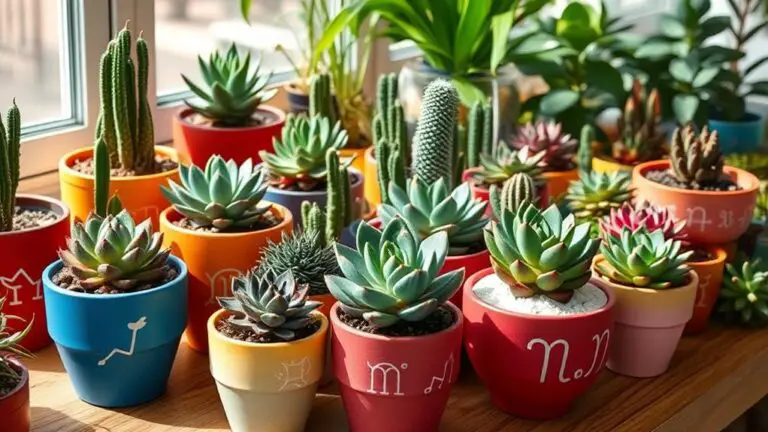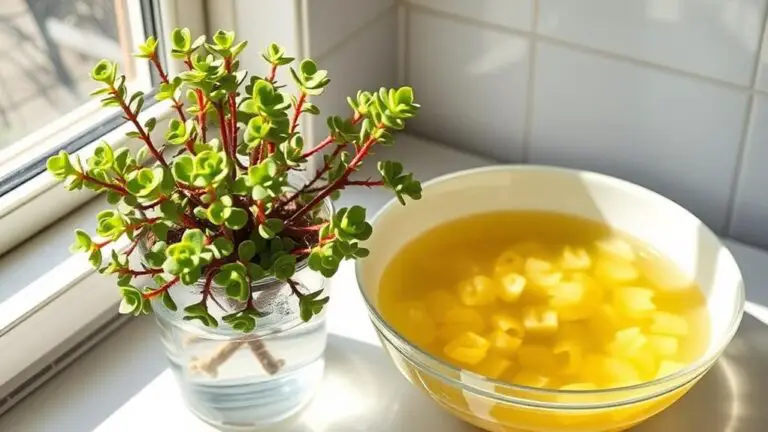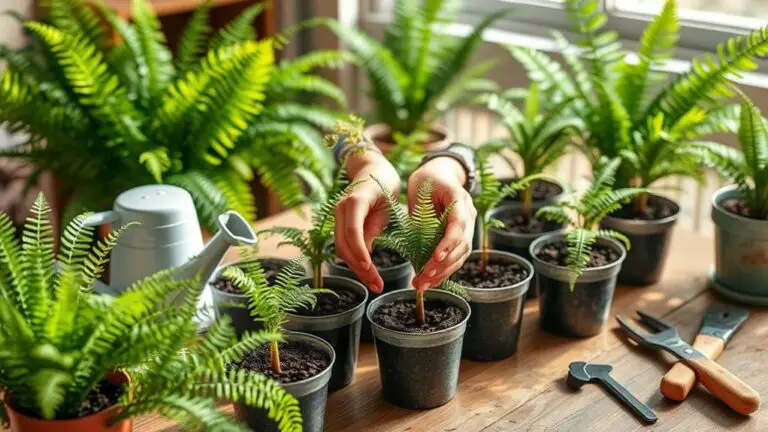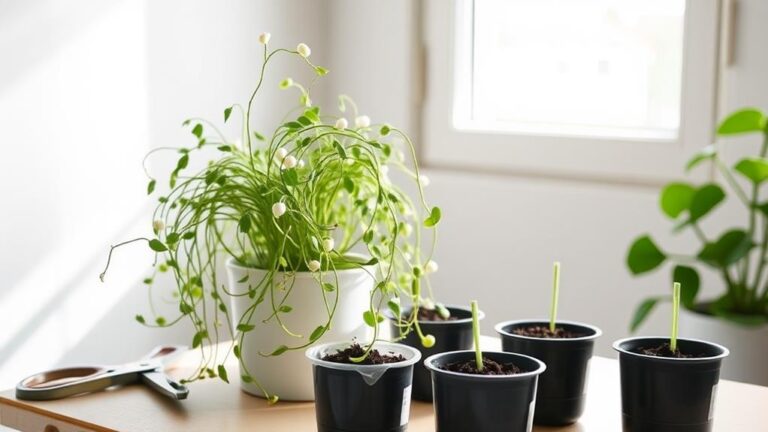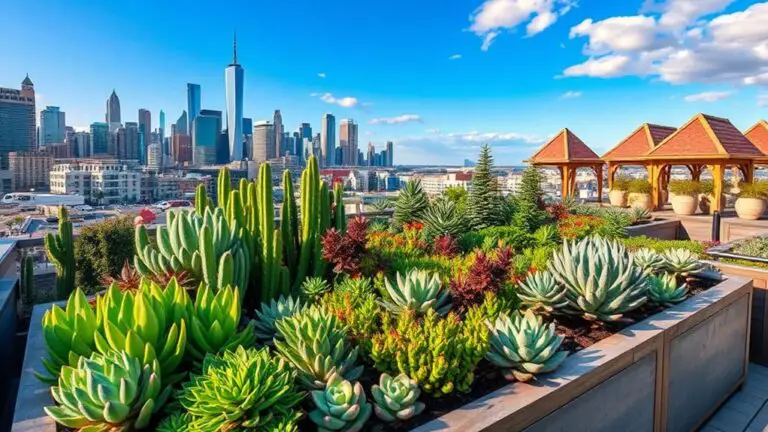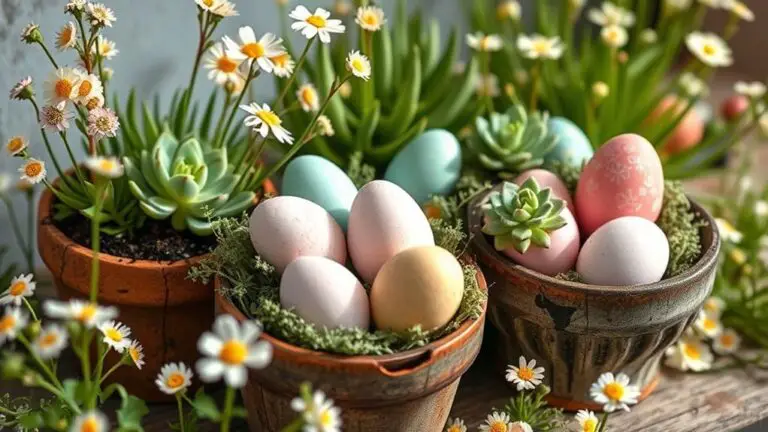5 Essential Steps to Care for Sedum Minor
When caring for Sedum Minor, you need to follow a few essential steps to guarantee your plant thrives. Start by choosing a sunny location, as this succulent requires at least six hours of sunlight daily. Watering wisely is vital, letting the soil dry out completely between waterings, especially during the colder months. Optimizing soil conditions with a succulent mix and improving drainage using perlite or sand will help maintain healthy roots. Pruning during the growing season keeps the plant's shape and boosts airflow. However, addressing common issues like overwatering and pests can be the difference between a flourishing plant and a struggling one. So, how do you tackle these challenges effectively?
Choose the Right Location

Choosing the right location for your Sedum Minor is vital for its success. You'll want to find a spot that gets plenty of full sun. This means at least 6 hours of direct sunlight every day. Sedum thrives in these conditions, guaranteeing the best growth and flowering during the growing season.
It's also critical to choose well-drained soil. Sedum prefers soil with a neutral to slightly alkaline pH, so avoid heavy clay. Clay holds too much water and can lead to root rot, which you definitely don't want.
Rocky areas or sandy spots are perfect for planting Sedum Minor. These environments naturally provide good drainage, which is what Sedum needs. Make certain the location you choose isn't shaded too much. While some creeping varieties of Sedum can handle part shade, full sun will give you the healthiest plants.
Another thing to keep in mind is spacing. Plant your Sedum Minor about 6 to 12 inches apart. This guarantees they've enough room to grow and allows for adequate airflow. Overcrowding can lead to problems, so proper spacing helps prevent them.
Following these tips will set your Sedum Minor up for success!
Water Wisely
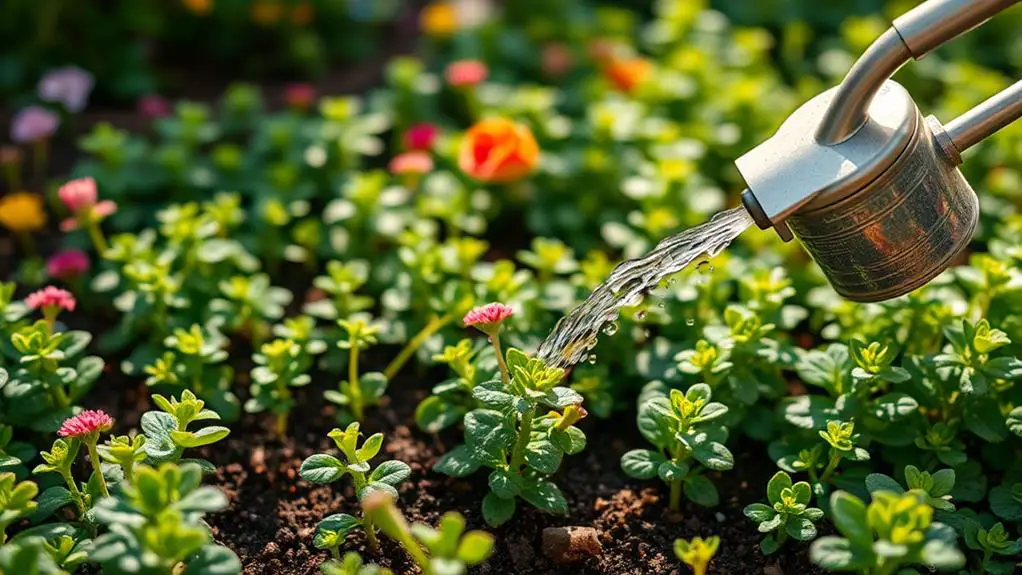
When it comes to watering Sedum Minor, proper technique is essential for maintaining its health. This drought-tolerant plant prefers a careful balance between too much and too little water.
To water wisely, start by thoroughly watering Sedum Minor during its first year. This helps establish a strong root system.
Throughout the growing season, from spring to early fall, you should increase your watering frequency. However, always check the top 1-2 inches of soil for dryness before you water again. Let the soil dry out completely between waterings to prevent root rot. The soak and dry method works best here. Soak the plant thoroughly, then let the soil dry out completely before the next watering.
In winter, reduce the watering considerably since Sedum Minor enters a dormant phase and needs less water.
Make sure to monitor for signs of underwatering, like shriveled leaves, and adjust your watering schedule accordingly.
Optimize Soil Conditions
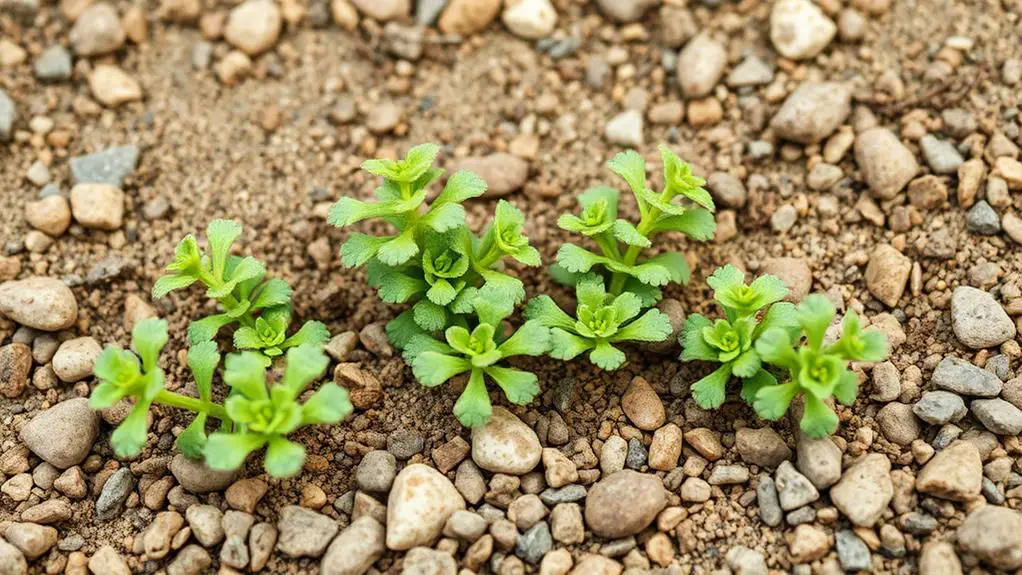
Optimizing soil conditions is vital for the health and growth of Sedum Minor. First, you need to guarantee that your sedums are planted in well-draining soil. This is essential to prevent root rot, a common problem caused by overwatering. A succulent mix is ideal because it mimics the natural rocky habitats where sedums thrive.
Pay attention to the soil's pH as well. Sedum Minor prefers neutral to slightly alkaline soil. You can test the soil pH using a simple kit available at most garden centers. If the pH isn't right, you can amend it with lime to make it more alkaline.
To further enhance drainage, mix in perlite, coarse sand, or grit with your soil. These materials help water flow through the soil more easily, preventing water from sitting around the roots.
Also, regularly check the soil moisture. Allow the top 1-2 inches to dry out completely between waterings. This practice helps maintain the ideal soil moisture for Sedum Minor.
Lastly, using terracotta pots can be beneficial. Their porous nature allows better moisture evaporation, reducing the risk of overwatering.
Prune and Maintain
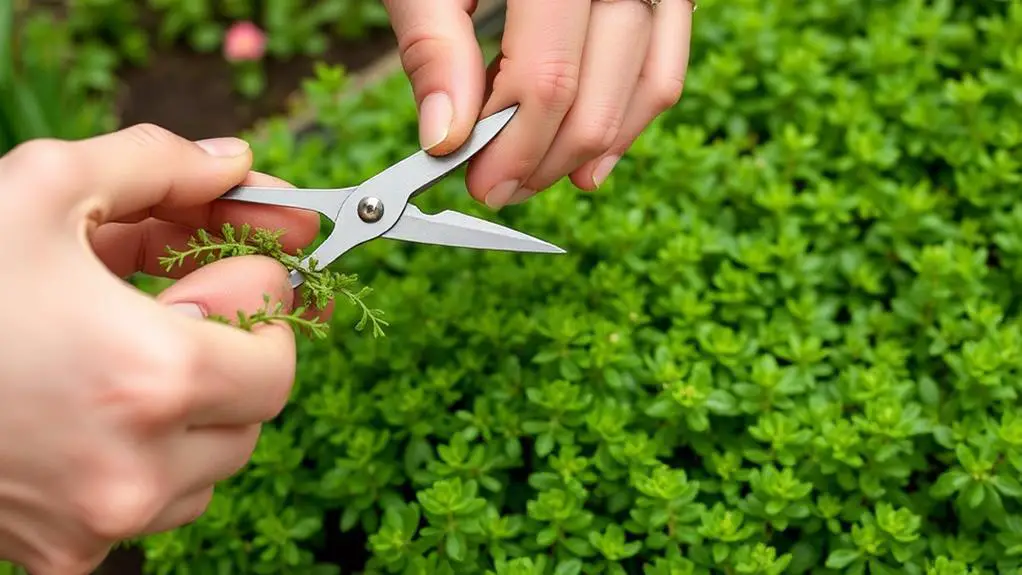
Pruning and maintaining your Sedum Minor is vital for its health and appearance. You should prune during the growing season, which is usually in spring or summer. This helps remove dead or damaged parts and encourages new growth.
Regular trimming guarantees the plant maintains its shape, preventing it from becoming leggy or overgrown. A well-maintained Sedum Minor will look dense and attractive.
Start by inspecting your Sedum Minor for any dead leaves or diseased parts. Use sharp, clean scissors to make cuts, which promotes healthy growth.
After pruning, it's important to let the plant rest without watering immediately. This helps prevent rot, especially in the cut areas.
Pay attention to any overly long stems or foliage. Pruning these back will improve airflow around the plant, reducing the risk of powdery mildew.
This is particularly important in the summer when plants can become densely packed.
Address Common Issues
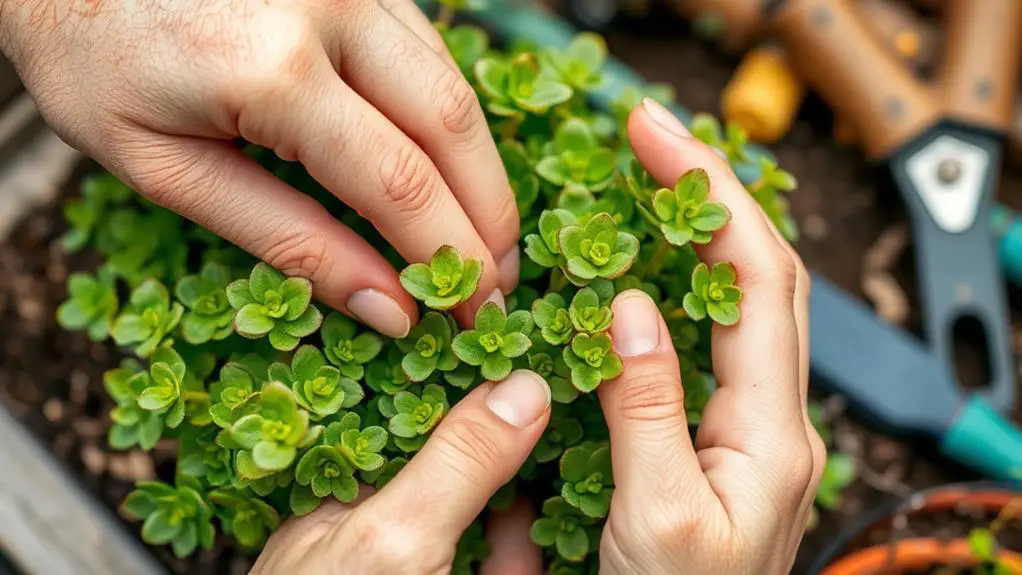
To keep your Sedum Minor healthy, it's important to address common issues promptly. Overwatering is the most common problem, often leading to root rot. You can spot this by looking for yellowing leaves and mushy stems. Make sure the top 1-2 inches of soil dry out before you water again.
On the flip side, underwatering can cause your plant's leaves to shrivel. Regularly check the soil's moisture to avoid this.
Pests like mealybugs and aphids can damage your Sedum Minor. Inspect your plant regularly and treat any infestations right away.
Fungal diseases, such as powdery mildew, are another concern. These often appear in overly humid conditions. To prevent fungal issues, maintain proper air circulation and avoid excessive humidity around your plant.
Nutrient deficiencies can also affect your Sedum Minor, leading to pale leaves and stunted growth. To keep your plant thriving, use a balanced fertilizer every 4-6 weeks during the growing season. This will provide the crucial nutrients your plant needs.
Frequently Asked Questions
How to Maintain Sedum Plants?
Make sure your sedum plants get at least 6 hours of sunlight daily. Water thoroughly but let the soil dry out between waterings. Use well-draining soil, fertilize every 4-6 weeks, and prune dead leaves occasionally.
How to Care for Sedum Dasyphyllum Minor?
To care for Sedum Dasyphyllum 'Minor,' place it in direct sunlight for 6 hours daily. Water using the soak and dry method, use well-draining soil, keep temperatures between 65°F-80°F, and repot every 1-2 years.
How Do I Make My Sedum Grow Better?
To make your Sedum grow better, give it at least 6 hours of sunlight daily. Use well-draining soil, water with the soak and dry method, fertilize every 4-6 weeks, and regularly prune dead leaves.
How to Keep Sedum From Getting Leggy?
Make sure your Sedum Minor gets at least 6 hours of sunlight daily and let the soil dry between waterings. Prune regularly and space plants 6 to 12 inches apart. Use a low-nitrogen fertilizer sparingly.
Conclusion
By following these five steps, you'll have a thriving Sedum Minor in no time. Remember to pick a sunny spot, let the soil dry out between waterings, and use the right soil mix. Don't forget to prune during the growing season and tackle any problems quickly. You've got this! With a bit of care and attention, your Sedum Minor will grow beautifully, adding a lovely touch to your garden. Happy gardening!


